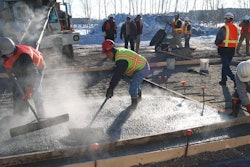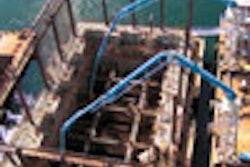When opting to take on a building project, owners must weigh a variety of factors. Speed of construction, economy and architectural appeal are often the first items that pop into one’s mind.
However, today’s savvy owners also recognize the importance of a dependable and consistent building solution that will offer long--term durability and efficiency. Site--cast tilt--up construction continues to expand as the solution of choice for a widening variety of end--use buildings from schools to churches to corporate facilities. Ranging from small start--up firms to Fortune 500 companies, owners across the globe are selecting tilt--up for their retail stores, headquarters and distribution centers because it is a consistent solution for their building needs.
How is tilt--up consistent?
Although tilt--up can be customized for each individual project’s needs, a combination of training, industry resources and proven design and construction techniques ensure consistency on a tilt--up project, regardless of location, end--use, schedule or budget. One key element for creating consistency throughout the industry is the certification program that is offered by the Tilt--Up Concrete Association (TCA) in conjunction with the American Concrete Institute (ACI). Field personnel can gain ACI certification as tilt--up technicians or, with required experience, tilt--up supervisors. Many municipalities and owners now require this certification as a project prerequisite. Further, having certified technicians or supervisors separates your firm from the competition and demonstrates your commitment to quality.
In addition to certification, experienced tilt--up professionals employ a variety of proven techniques. Quality control in panel production is achieved through review and approval of shop drawing submittals including concrete mix design, bondbreaker and curing compound selection, formliners and reveal details, grouting and patching materials, aggregate samples, reinforcing chairs, as well as finishes and coatings. Sample panels help to establish the desired finish level and appearance early in the construction process, while site inspections to review panel construction ensure conformance with the construction documents. Additionally, testing agencies are employed to ensure proper structural strength of the concrete.
Beyond proven field techniques, the increasing number of design professionals supporting the tilt--up industry benefit from a variety of resources. Effective design resources include TCA’s Tilt--Up Engineering and Construction Manual, finite--element design software from the Portland Cement Association (PCA), as well as a variety of wall panel design programs from private companies.
Success through consistency
Consistency of construction also is a factor for companies seeking global solutions for their business enterprise. Such was the case for Rooms to Go – one of America’s leading furniture retailers. The company recognized the need to construct a high--tech distribution center in Toa Baja, Puerto Rico, to serve as the supply center to area retail stores, as well as future Caribbean locations. Even though buildings in Puerto Rico are typically constructed using precast panels, the developer – Seaman Development Corp. of Franklin, Tenn. – uses tilt--up exclusively for distribution centers in the United States and has grown accustomed to the durability, consistency, speed and quality afforded with this method. According to the tilt--up concrete subcontractor on the project, Seretta Construction of Apopka, Fla., the project was a success despite the challenges of introducing a new construction method to a geographic area.
One of the most challenging aspects of this project was getting the materials such as lumber, reinforcement and concrete to the site in a timely manner. Arrangements were made prior to construction to have the majority of the equipment, including a screed, troweling machines, Soff--Cut saws, reveals, chamfer and all required tools packed into a site trailer and shipped to Puerto Rico. This was necessary because many of the items were not available on the island. On more than one occasion, however, delays of nearly two weeks were experienced while reinforcement was manufactured and fabricated. To counter this challenge, crews worked 12--hour days, six days a week when materials were available.
Fast track to head of the class
Yet another example of consistency enabling success is in the education market – arguably the most booming market for members of the construction industry. Schools throughout the country face problems with old and decaying facilities or simply are overcrowded. As such, speed and consistency are crucial. Responding to the needs of a growing community and based on a successful track record using the method, the Central West Palm Beach School District selected tilt--up for the construction of nine school buildings clustered together on a tight site. According to subcontractor Woodland Construction Co., tilt--up was the only means to meet the demanding 18--week schedule for shell construction of all nine structures.
“Tilt--up allowed the school board to respond quickly to the increasing student enrollment through the delivery of facilities for approximately 1,200 students in a mere year,” says Clay Fischer, president of Woodland Construction Co. “The consistency afforded by the tilt--up method allowed for this milestone.”
However, consistency does not equate to cookie--cutter as each of the structures has its own unique attributes. Five of the buildings are multistory, and the auditorium presented special challenges with sloped floors and 50--ft. ceilings in the gymnasium. Yet, according to Fischer, integration of certified tilt--up professionals, proven field techniques and efficient design created project success.
Creating a sanctuary
Consistency also translates to long--term value, and today’s owners certainly desire building solutions that provide a high resale. For example, the Cornerstone Fellowship church in Livermore, Calif., needed a new facility that would accommodate the growing congregation and scope of services, activities and community reach. Recognizing the challenge associated with raising funds for a new religious facility, Balch Enterprises – a full--service, vertically integrated builder/developer in Hayward, Calif. – presented the idea to redevelop a vacant 62,000--sq.--ft. indoor sports facility to meet the church’s needs.
Constructed in the early 1990s, the original structure used load--bearing tilt--up wall panels. Therefore, the building had few interior columns, allowing the design team to transform the majority of the original structure into a 2,000--seat sanctuary with the help of seating structures cast inside the facility with tilt--up techniques. By relocating two 70,000--lb. tilt--up walls panels, the team easily added 14,000 sq. ft. to the building footprint which today comprises a stage and event area, nursery, classrooms and a youth center. Further, with the construction of a 34,000--sq.--ft. second floor containing additional offices and classrooms, the facility is now about 110,000 sq. ft. in size. A 10,000--sq.--ft. courtyard dramatically upgraded the image of the facility, allowing congregants to feel like they are more a part of a neighborhood than an industrial setting.
Looking ahead
As more owners turn to tilt--up to provide the long--term building solution they desire, successful contractors will continue to employ the consistent practices that have made tilt--up a method of choice for decades.
“Without a doubt, the landscape of tilt--up construction is changing rapidly,” says Jim Baty, technical director for the TCA. “Spurred by outstanding design concepts inspired by the expanding creativity of architects and engineers, we are seeing an ever--increasing growth in the talent of contractors to produce the final results. What’s most impressive is that these results are being attained with decreased schedules and award--winning attention to detail.”
Ed Sauter is the executive director of the Tilt--Up Concrete Association. This year’s series on site--cast tilt--up construction will help experienced contractors sell the method to owners and educate contractors just getting started with tilt--up about all the benefits the medium offers. This article is the first in the series. For more information about TCA, visit www.tilt-up.org or call (319) 895--6911.

















